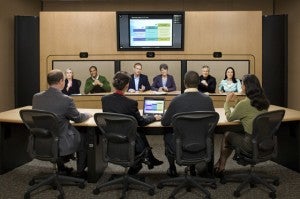
Business executives with an upcoming meeting have two choices: they can pack their things, travel to the airport, catch a flight, unpack in a hotel, and take a cab to an office…or they can walk into another room and watch a TV. Teleconferencing has come into its own with major corporations slashing their enormous travel budgets in favor of high-tech video and audio equipment. Two leading systems, Halo from Hewlett Packard and Telepresence from Cisco, are feeding the transition from airports to broadband. Major airlines are reporting drops in business travel of close to 30% as companies look for ways to save money and avoid jetlag. Check out the demo videos for Telepresence and a CNET review of Halo after the break.
According to Mercury News, Silicon Valley companies have been leading the way with replacing expensive air travel with (relatively) cheaper video conferencing. Cisco trimmed its own travel budge from $740 million to $240 million. AMD executive Linda Starr went from logging a million air miles per year to just 100,000. Hewlett Packard cut travel expenses by 30% from 2007 to 2008, and is looking to do so again from 2008 to 2009. Higher quality video, crystal clear sound, and a lack of noticeable delay makes the current generation of corporate conferencing a viable substitution for face to face meetings. As remote presence technology improves, incorporating the ability to feel physical objects using haptics, we could see the business flight go the way of the dodo.
Uninterrupted video and audio feed doesn’t come cheap. Prices for Cisco’s Telepresence ranges from $34,000 to $340,000. HP offers Halo for $120,000 to $350,000 with an additional monthly fee of $10,000 to $18,000. Both companies have installed hundreds of their systems worldwide. Cisco claims that in their own corporation alone they have installed 530 Telepresence conference rooms and conducted over 350,000 meetings.
There are other companies competing for the teleconference market. Teliris‘ product, also called Telepresence, is designed to run on a business’ existing networking system, avoiding upgrade costs. Tandberg is partnered with Siemens Enterprise and is actively expanding into Asian markets. Polycom generated some PR buzz earlier this month by highlighting their work with telehealth and telemedicine. Each of these companies is set to contend with the much larger HP and Cisco.
As always, I’m not so concerned with picking a winner in a competitive field as I am with evaluating the field itself. While retail level webcams and conferencing is slow and troublesome, I still use it on a regular basis quite happily. Business meetings over the net are as ‘real’ to me as physical ones. I can imagine this perception would only be enhanced with the level of clarity offered by Telepresence or Halo. Once conferencing includes 3D holograms the telepresence experience will be even better.
Looking forward, the trend would seem clear: as teleconference reliability increases, so will its acceptance. Routine air travel is expensive, environmentally unfriendly, and draining on your health. Teleconferencing is the way of the future, and it is set to replace a large portion of business travel. It may also lead to a greater geographic diversity of corporate headquarters. Why pay Manhattan prices when you can teleconference from Ohio just as easily?
[photo credit HP]



